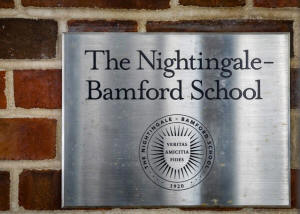|
Trans students: A test of identity for
U.S. girls schools
 Send a link to a friend
Send a link to a friend
 [August 20, 2018]
By Tea Kvetenadze [August 20, 2018]
By Tea Kvetenadze
NEW YORK (Reuters) - Secondary schools for
girls across the United States are grappling with a difficult and
increasingly common question: what is the best approach when a student
or applicant no longer identifies as female or is going through a gender
transition?
As students who are openly transgender or non-binary - those who
identify as neither male nor female - have become more visible at girls
schools in recent years, educators are re-defining policies on
admission, retention and other issues.
The challenge, experts say, is to create policies that support and
respect students while preserving the historic mission of these schools
to educate and empower young women in exclusively female environments.
But many schools have yet to clarify policies related to gender
identity, and that could keep some students from being open about their
gender expression, said Joanne Glusman, president of the Main Line Youth
Alliance, who works with adolescents who are lesbian, gay, bisexual,
transgender or queer.

"There are certainly kids who don't feel safe or comfortable coming out
in their single-sex school," Glusman said.
Studies have shown transgender youth are often bullied and are more at
risk of depression, anxiety, and suicide, among other mental health
concerns, than their non-trans peers.
A study by the University of Minnesota published in the journal
Pediatrics found that almost 3 percent of 9th through 12th graders
identified as transgender or gender-nonconforming, a term used to
describe those who don't conform to traditional gender conventions. On
that basis, hundreds if not thousands of trans and non-binary students
likely attend the about 375 girls schools in the United States, though
no precise count exists.
"Middle school and high school, that's when you really start learning
more about yourself and growing," said Ezra Morales, 18, a trans, gender
non-conforming activist who recently graduated from the Ann Richards
School For Girls in Austin.
Among the dozens of girls schools contacted by Reuters, several said
they had already developed transgender policies, some said they are
having early discussions or have created taskforces and a number of
others have taken no action.
Many schools said they decide on a case-by-case basis whether a
non-binary or transgender student who no longer identifies as a girl
will stay, either as a matter of policy or in anticipation of more
specific guidelines.
That approach is in keeping with recommendations from a National
Coalition of Girls' Schools taskforce that educators make such decisions
on "an individual basis," rather than codifying rigid policies.
But making case-by-case decisions can present problems due to the
conscious or unconscious biases of administrators, according to Davey
Shlasko, founder of Think Again, which trains schools on issues such as
trans inclusion. That raises questions about basic fairness and could
put a school in legal jeopardy, he said.
Several schools, including the prestigious Marlborough School in Los
Angeles and Nightingale-Bamford on Manhattan's Upper East Side, have
policies considering any applicant who identifies as female, including
those assigned male at birth.
[to top of second column]
|

A plaque is seen in the entrance way to the Nightingale-Bamford
School, an independent K-12 girls' school, in New York City, U.S.,
August 18, 2018. REUTERS/Brendan McDermid

When it comes to retaining transitioning students who are already
enrolled, Nightingale is "very much taking the case-by-case
position," said Head of School Paul Burke.
With enrolled students who identify as male or gender-nonconforming,
he said Nightingale prefers to have a dialogue to make sure the
school is still the best environment for them.
In recent years, Nightingale and other schools have made more
trans-inclusive accommodations such as dropping the tradition of
students wearing white dresses at graduation, a practice that Burke
described as "clearly gendered."
'WE'RE NOT THERE YET'
But there are some girls schools that have not developed policies
despite having openly trans or non-binary students.
The National Cathedral School, an Episcopal day school in Washington
D.C., has no formal policy even though they've had students
transition in the past. "We're not there yet," said Scott
Butterworth, the school's director of communications.
Stoneleigh-Burnham in Massachusetts, Carrollton School of the Sacred
Heart in Miami and Kent Place in New Jersey also have no formal
transgender protocols but say they are discussing the issue.
Brearley, an exclusive private New York day school, said in its
gender diversity statement it would accept any female-identifying
applicant and work with and support transitioning pupils, including
accommodating their choice of name and pronoun. They will, however,
continue to refer to students en masse as "girls" or "young women."

Marlborough adopted practices two years ago for those who no longer
identify as female: it allows students in 12th grade to graduate and
treats 11th graders on a case-by-case basis, but younger students
are asked to switch schools.
The school concedes that its practices could very well change in the
future, however, as its thinking about the issue evolves.
"We're never going to be static," said Head of School Priscilla
Sands. "We're never going to say: 'That's what we wrote in 2016 and
that's what it will be forever.'"
(Editing by Frank McGurty and Susan Thomas)
[© 2018 Thomson Reuters. All rights
reserved.]
Copyright 2018 Reuters. All rights reserved. This material may not be published,
broadcast, rewritten or redistributed.
Thompson Reuters is solely responsible for this content. |